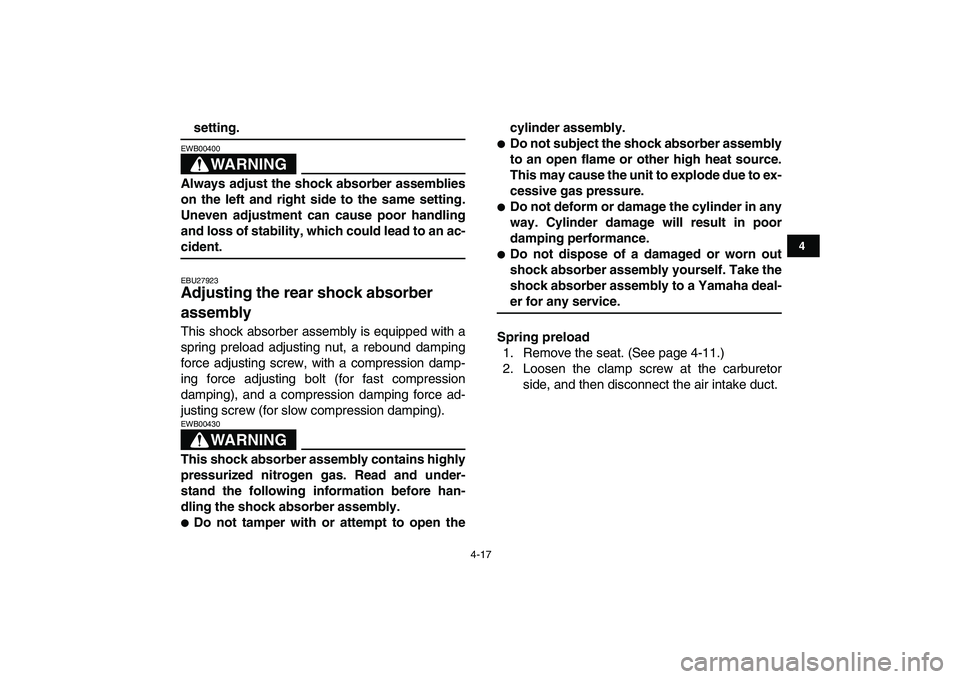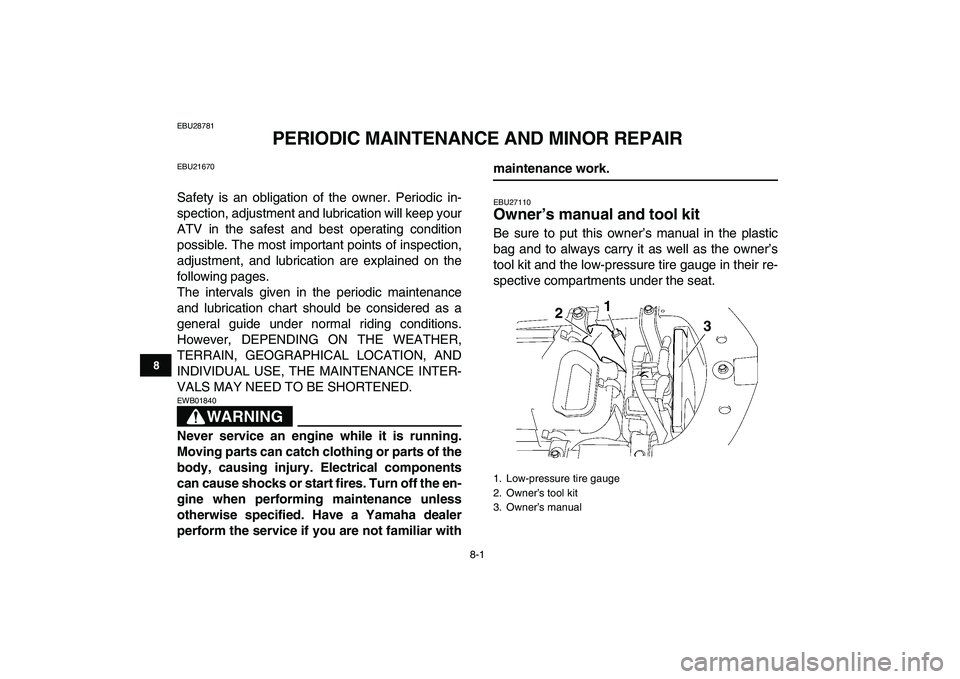Page 34 of 148

4-12
1
2
34
5
6
7
8
9
10
11
EBU27903
Adjusting the front shock absorber
assemblies
These shock absorber assemblies are equipped
with a spring preload adjusting nut, a rebound
damping force adjusting screw, with a compres-
sion damping force adjusting bolt (for fast com-
pression damping), and a compression damping
force adjusting screw (for slow compression damp-
ing).
WARNING
EWB00410
These shock absorber assemblies contain
highly pressurized nitrogen gas. Read and un-
derstand the following information before han-
dling the shock absorber assemblies.
�
Do not tamper with or attempt to open the
cylinder assemblies.
�
Do not subject the shock absorber assem-
blies to an open flame or other high heat
source. This may cause the unit to explode
due to excessive gas pressure.
�
Do not deform or damage the cylinders in
any way. Cylinder damage will result in poor
damping performance.
�
Do not dispose of a damaged or worn out
shock absorber assembly yourself. Take the
shock absorber assembly to a Yamaha deal-
er for any service.
Spring preload
1. Loosen the locknut.
2. Turn the adjusting nut in direction (a) to in-
crease the spring preload and thereby harden
the suspension, and in direction (b) to de-
crease the spring preload and thereby soften
1. Projection
2. Seat holder
1
2
Page 39 of 148

4-17
1
2
34
5
6
7
8
9
10
11
setting.
WARNING
EWB00400
Always adjust the shock absorber assemblies
on the left and right side to the same setting.
Uneven adjustment can cause poor handling
and loss of stability, which could lead to an ac-
cident.
EBU27923
Adjusting the rear shock absorber
assembly
This shock absorber assembly is equipped with a
spring preload adjusting nut, a rebound damping
force adjusting screw, with a compression damp-
ing force adjusting bolt (for fast compression
damping), and a compression damping force ad-
justing screw (for slow compression damping).
WARNING
EWB00430
This shock absorber assembly contains highly
pressurized nitrogen gas. Read and under-
stand the following information before han-
dling the shock absorber assembly.
�
Do not tamper with or attempt to open thecylinder assembly.
�
Do not subject the shock absorber assembly
to an open flame or other high heat source.
This may cause the unit to explode due to ex-
cessive gas pressure.
�
Do not deform or damage the cylinder in any
way. Cylinder damage will result in poor
damping performance.
�
Do not dispose of a damaged or worn out
shock absorber assembly yourself. Take the
shock absorber assembly to a Yamaha deal-
er for any service.
Spring preload
1. Remove the seat. (See page 4-11.)
2. Loosen the clamp screw at the carburetor
side, and then disconnect the air intake duct.
Page 46 of 148

5-1
1
2
3
45
6
7
8
9
10
11
EBU19200
PRE-OPERATION CHECKS
EBU19220
Pre-operation check list
Before operating this ATV, be sure to check the items listed in the following table.
NOTE:
The maintenance of some items in the table has to be performed by a Yamaha dealer. Refer to the “Periodic
maintenance and lubrication chart” on page 8-3 to determine which service should be performed by a
Yamaha dealer.
ITEM ROUTINE PAGE
Fuel
�
Check fuel level in fuel tank, and add recommended fuel if neces-
sary.
�
Check fuel line for leakage. Correct if necessary.4-8, 5-4
Engine oil
�
Check oil level in engine, and add recommended oil to specified
level if necessary.
�
Check ATV for oil leakage. Correct if necessary.5-4, 8-14
Coolant
�
Check coolant level in reservoir, and add recommended coolant to
specified level if necessary.
�
Check cooling system for leakage. Correct if necessary.5-4, 8-20
Front brake
�
Check operation. If soft or spongy, have Yamaha dealer bleed
hydraulic system.
�
Check brake pads for wear, and replace if necessary.
�
Check brake fluid level in reservoir, and add recommended brake
fluid to specified level if necessary.
�
Check hydraulic system for leakage. Correct if necessary.5-4, 8-31, 8-32, 8-36
Page 84 of 148

8-1
1
2
3
4
5
6
78
9
10
11
EBU28781
PERIODIC MAINTENANCE AND MINOR REPAIR
EBU21670
Safety is an obligation of the owner. Periodic in-
spection, adjustment and lubrication will keep your
ATV in the safest and best operating condition
possible. The most important points of inspection,
adjustment, and lubrication are explained on the
following pages.
The intervals given in the periodic maintenance
and lubrication chart should be considered as a
general guide under normal riding conditions.
However, DEPENDING ON THE WEATHER,
TERRAIN, GEOGRAPHICAL LOCATION, AND
INDIVIDUAL USE, THE MAINTENANCE INTER-
VALS MAY NEED TO BE SHORTENED.
WARNING
EWB01840
Never service an engine while it is running.
Moving parts can catch clothing or parts of the
body, causing injury. Electrical components
can cause shocks or start fires. Turn off the en-
gine when performing maintenance unless
otherwise specified. Have a Yamaha dealer
perform the service if you are not familiar with
maintenance work.
EBU27110
Owner’s manual and tool kit
Be sure to put this owner’s manual in the plastic
bag and to always carry it as well as the owner’s
tool kit and the low-pressure tire gauge in their re-
spective compartments under the seat.
1. Low-pressure tire gauge
2. Owner’s tool kit
3. Owner’s manual
3 21
Page 85 of 148
8-2
1
2
3
4
5
6
78
9
10
11
The service information included in this manual
and the tools provided in the owner’s tool kit are in-
tended to assist you in the performance of preven-
tive maintenance and minor repairs. However,
additional tools such as a torque wrench may be
necessary to perform certain maintenance work
correctly.
NOTE:
If you do not have the tools or experience required
for a particular job, have a Yamaha dealer perform
it for you.
WARNING
EWB01850
Never modify this ATV through improper in-
stallation or use of accessories, as it may
cause changes in handling, which in some sit-
uations could lead to an accident. All parts and
accessories added to this ATV should be gen-
uine Yamaha or equivalent components de-
signed for use on this ATV and should be
installed and used according to instructions. If
you have questions, consult an authorized
Yamaha ATV dealer.
Page 91 of 148
8-8
1
2
3
4
5
6
78
9
10
11
EBU23070
NOTE:
�
The air filter needs more frequent service if you are riding in unusually wet or dusty areas.
�
Hydraulic brake service
�
Regularly check and, if necessary, correct the brake fluid level.
�
Every two years replace the internal components of the brake master cylinders and calipers, and
change the brake fluid.
�
Replace the brake hoses every four years and if cracked or damaged.
Page 119 of 148

8-36
1
2
3
4
5
6
78
9
10
11
EBU24390
Checking the front brake lever free play
The brake lever free play must be checked at the
intervals specified in the periodic maintenance and
lubrication chart. The brake lever should have a
free play of zero mm (zero in) as shown. If the free
play is incorrect, have a Yamaha dealer check the
brake system.
WARNING
EWB02070
Operating with improperly serviced or adjust-
ed brakes could cause loss of braking ability,
which could lead to an accident.After servicing:
�
Make sure the brakes operate smoothly and
that the free play is correct.
�
Make sure the brakes do not drag.
�
Make sure the brakes are not spongy. All air
must be bled from the brake system.
Replacement of brake components requires
professional knowledge. These procedures
should be performed by a Yamaha dealer.
EBU24611
Checking the brake pedal position
The brake pedal position must be checked and, if
necessary, adjusted at the intervals specified in
the periodic maintenance and lubrication chart.
The top of the brake pedal should be positioned
11.7 mm (0.46 in) below the top of the footrest as
shown. If the brake pedal is not positioned as spec-
ified, have a Yamaha dealer adjust it.
1. Brake lever free play
1
Page 120 of 148
8-37
1
2
3
4
5
6
78
9
10
11
WARNING
EWB02110
Operating with improperly serviced or adjust-
ed brakes could cause loss of braking ability,
which could lead to an accident.
After servicing:
�
Make sure the brakes operate smoothly and
that the brake pedal position is correct.
�
Make sure the brakes do not drag.
�
Make sure the brakes are not spongy. All air
must be bled from the brake system.
Replacement of brake components requires
professional knowledge. These procedures
should be performed by a Yamaha dealer.
EBU24710
Adjusting the parking brake free play
The parking brake free play must be checked and,
if necessary, adjusted at the intervals specified in
the periodic maintenance and lubrication chart.
Cable length “A” should measure 47–51 mm (1.9–
2.0 in). Adjust the parking brake free play as fol-
lows.
1. Release the parking brake by moving the
1. Brake pedal position
1
1. Adjusting bolt
2. Cable length “A”
3. Locknut
2
3
1